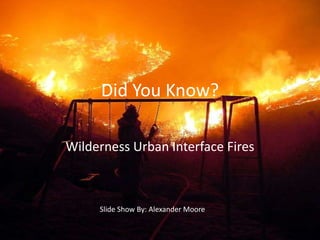
Did You Know WUI
- 1. Did You Know? Wilderness Urban Interface Fires Slide Show By: Alexander Moore
- 2. Wilderness Urban Interface (WUI) is defined by the United States Forest Service as being: “where structures and other human development meet or intermingle with undeveloped wildland or vegetative fuels,”
- 3. Construction in the Wilderness Urban Interface is booming! One statistic states… “In the Western U.S. alone, of new home construction is adjacent to or intermixed with the WUI.” 38%
- 4. In 2020 the United States will have an estimated 341,386,665 people according to the U.S. Census Bureau. This trend of expanding into the wilderness is unlikely to change. 31,153,802 more people than this year (2010).
- 5. These statistics are troublesome considering they all point to more people in the WUI and… …human activity is 7 times more likely to be the cause of a wildland fire than that of lightning strikes [a common natural cause].
- 6. Wilderness Urban Interface Fires affect all socioeconomic groups. In the picture white X’s represent lost homes. In 1961 a Wilderness Urban Interface Fire even destroyed structures in the wealthy Los Angeles neighborhood Bel-Air.
- 8. Fire friendly weather (high winds, low humidity, high temperatures, lack of precipitation)
- 10. An example of a WUI disaster are the California Wildfires of 2008, which caused 1.4 billion dollars of property damage. To put that in perspective, the property damage statistic for the entire nation in 2008 was 15.5 billion dollars.
- 11. Structure ignitability (arguably the easiest factor to influence when thinking about fire prevention in the WUI) is determined by: Materials used in construction. The structure’s surroundings, 100 – 200 feet in all directions.
- 12. 95% of homes survived a WUI incident when vegetation around the home was cleared and non-flammable roofing materials were used.
- 15. The WUI is most concentrated in Eastern and Southern states and the smaller states have the greatest percentage of land mass in the WUI.
- 17. 38.5% of all homes in the U.S. are in the WUI.
- 19. Be Safe! Be Smart!
- 20. Picture Sources In Order of Use http://www.wildfirelessons.net/uploads/WUI_Picnic_Rock_Fire_BLM.jpg http://www.lkjh.org/bike/california/la/topanga/f0310.jpg http://www.nycustomhomes.com/images/background3.jpg http://www.lafire.com/famous_fires/611106_BelAirFire/LAFDreport_1/photo2.gif http://www.fs.fed.us/r2/psicc/spl/harrispark.jpg http://www.crustal.ucsb.edu/about/annual_reports/2006-2007/images/EP-OwlCanyon-crop.jpg http://gazebo.raisearoof.com/images/standard_cedar_shingle0pop.jpg http://awarebrain.files.wordpress.com/2009/02/gardenhosefire.jpg http://z.about.com/d/sanfrancisco/1/0/R/W/-/-/DSC_1344.jpg http://graphics8.nytimes.com/images/2008/10/13/us/14WILDFIRES600_READY.jpghttp://www.ci.tumwater.wa.us/picts/log%20cabin%20small.jpg http://www.foresthistory.org/publications/FHT/FHTFall2008/Cohen.pdf www.Life.com www.life.com http://www.nrs.fs.fed.us/pubs/gtr/gtr_nrs1/stewart_1_197.pdf http://www.firewise.org/
- 22. USFA Fire Statistics (Quick Stats)
- 23. USFA TOPICAL FIRE RESEARCH SERIES:Fires in the Wildland/Urban Interface
- 24. The Wildland-Urban Interface in the United States by Stewart, Radeloff, and Hammer
- 25. The Wildland-Urban Interface Fire Problem: A Consequence of the Fire Exclusion Paradigm by Jack Cohen
- 26. The Firewise Communities website at www.firewise.org
- 27. The Los Angeles Fire Department Historical Archive at www.lafire.com